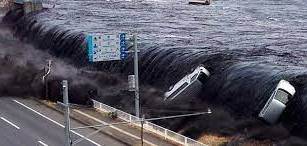
The massive volcanic eruption off the coast of Tonga on January 15 produced an explosion hundreds of times greater than the force of the Hiroshima nuclear explosion, according to NASA.
The volcano and subsequent tsunami - which reached the United States, Peru, New Zealand and Japan - reinforced a Tongan proverb, "Motu ka na'e navei", or "always be prepared to a disaster ". The eruption has led experts to wonder how they can better manage the environmental impact of natural disasters.
“The effects of the eruption are a reminder of the need for greater and urgent investment in ecosystem-based disaster risk reduction and climate action to reduce the human and financial toll of natural disasters,” said Muralee Thummarukudy, Acting Head of the Global Disaster and Conflict Resilience Support Branch at the United Nations Environment Program (UNEP).
“Good environmental management, climate change impacts and disaster response are intertwined and require a more systematic and holistic approach to disaster risk management,” he added.
Human and planetary cost of disasters
At least three people have died in Tonga and more than 80% of the population has been affected by the disaster . The toxic ash caused by the eruption, which reached several South Pacific countries outside of Tonga, has multiple environmental impacts. This ash can contribute to acid rain and acid gas, affecting groundwater, drinking water, the food chain (including fisheries livelihoods) and ecosystems.
This is not an isolated incident. A 2020 report by the United Nations Office for Disaster Risk Reduction (UNDRR) shows that between 2019 and 2000 there were 7,348 recorded major disasters that claimed 1.23 million lives of people, affecting 4.2 billion people (many, on more than one occasion) and resulting in approximately $2.97 trillion in global economic losses.
UNEP and the United Nations Office for the Coordination of Humanitarian Affairs (OCHA) established the Joint Environment Unit (JEU) in 1994 to respond to environmental emergencies. The JEU coordinates international efforts and mobilizes partners to support countries that have requested assistance. In doing so, the JEU offers a range of services to address the links between the environment and emergencies .
2021 La Soufrière volcanic eruptions
“The GAME has experience responding to similar emergencies, most recently in Saint Vincent and the Grenadines and Barbados, where it responded to the La Soufrière volcanic eruptions in April and May 2021,” said Margherita Fanchiotti, GAME Response Focal Point.
During the emergency, the JEU deployed experts to St. Vincent, where the volcano is located, and to Barbados, which was affected by the ashfall. The team included environmental specialists with expertise in volcanology, ash management, environmental pollution (air, soil and water), ecology (with emphasis on marine ecosystems) and green answer. The JEU also helped with liaison and logistical support.
Over a period of three weeks, the team conducted rapid environmental assessments while advising national authorities on monitoring volcanoes and lahar (mud or debris flows) as well as cleanup and disposal of ash .
Lessons learned _
“Among the key environmental issues that have emerged there, and which are likely to be most relevant to Tonga and Fiji as well, are air quality – rated moderately hazardous under WHO guidelines – ash management and related water and soil contamination, sanitation issues in shelters, excessive use of plastics and the amount of waste generated by relief efforts,” Fanchiotti said. Others were the negative impacts on agriculture, livestock, marine ecosystems and ecotourism, with implications for food security and livelihoods .
The UNEP Handbook On Awareness and Preparedness for Emergencies at the Local Level ( Second Edition) helps to motivate and empower local leaders to prepare more effectively for emergencies and strengthen their resilience.
“The manual helps communities prevent loss of life, damage to health, well-being and livelihoods, minimize property damage and protect the environment,” Thummarukudy said. “It is applicable regardless of the nature of the environmental emergency. Whether it is an industrial accident, a disaster or a combination of events, such as those which could occur following an earthquake, a volcanic eruption or a tsunami after volcanic eruption in Tonga.
Extra information
As the world's leading environmental authority that sets the environmental agenda , UNEP continues to work to address natural hazards, disasters, industrial accidents and man-made crises in some of the world's most vulnerable communities. most vulnerable in the world. UNEP's work has supported countries such as Afghanistan, Colombia, Haiti, Iraq, Somalia, Sudan and South Sudan.
Posted on 2022-02-06 11:51








Comments